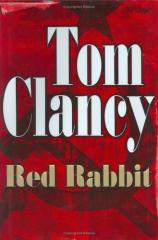Red Rabbit
Review
Red Rabbit
Tom Clancy makes demands upon his readers and upon himself. His
meticulous attention to detail is at once both fascinating and
maddening. Characters drop into the pages like swarms of
paratroopers; readers are advised to take notes to keep track of
all of them, particularly those with surnames unfamiliar to
Westerners. The length of his books are daunting, causing at least
one wag to comment that Clancy does not write books so much as
build doorstops. And yet, and yet...there is simply no denying that
there may well be no one who is more compelling an author currently
laboring in the field of fiction. And the latest exhibit in the
presentation of that argument is RED RABBIT.
Clancy is at the stage in his career where he can take chances; and
what greater risk can he take than writing a work of historical
fiction in which the end of the book is already known before one
even begins to read? Ah, but part of the joy of reading Clancy is
his opinions --- which, as any government op will tell you, are
more often revelations --- as to how that ending occurred. So too
with RED RABBIT, which occurs in the early 1980s, at the very
beginning of Jack Ryan's career with the CIA. Ryan's first day on
the job begins with his examination of a potentially explosive
document. The newly elected Pope, John Paul the Second, has
delivered a private ultimatum to the government of his beloved
native Poland and indirectly to that of the Soviet Union: If the
Polish government does not stop it's repression of its people, he
will resign the Papacy and return to Warsaw. Such an action would
be far more than a symbolic gesture: it would shake the foundations
of at least two governments and profoundly affect the actions of a
third. What the Pope knows, and what the CIA suspects, is that John
Paul has effectively written and signed his own death warrant. And,
indeed, Yuriy Andropov, the feared head of the KGB, has set the
wheels in motion to put a stop to the Pope's actions before they
even begin.
Knowing that John Paul does not fear his own death, and will
accordingly be undeterred by threats, Andropov steers his plot
through Kremlin intrigue, while Ryan, occasionally stymied by those
within the American government who don't believe that the Kremlin
would contemplate such an audacious plan, rushes to prevent it.
Clancy, however, won't be rushed, as he painstakingly, line by
line, paints a picture of a chess game between government forces as
they attempt to outguess, out think, and outmaneuver each other.
While the outcome is known, the events leading up to it, and the
event itself, have repercussions that continue to affect events
right up to the present. Clancy, as he has previously, demonstrates
an uncanny ability to pull back the curtain and reveal not only
what may have occurred, but also what almost assuredly did occur.
More than one higher-up, in more than one government, has been
known to cringe while reading a Clancy novel and say, "How the hell
did he know that?!" RED RABBIT will undoubtedly elicit similar
comments, and similar fears.
Clancy, ultimately, is a marvel. His analytical mind and canny
imagination have combined to create a body of work that at once has
redefined and recreated a genre in his own image. If his work is
challenging to read, it is a challenge worth undertaking both for
the journey and the destination.
Reviewed by Joe Hartlaub on January 23, 2011





